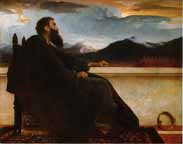The Times
'Mr Leighton's "David" (5) is the first picture to give us pause. This is one of our few painters who aims at style and the expression of a dominant idea. Here the aim seems to be at an embodiment of the weariness of life and labour in a great and good king. The crown lies at his feet unheeded, while the Jewish bard and monarch, with a worn and wistful face, gazes longingly after the doves that wing their way through a sky of rolling storm-clouds to a clear, sunlit space of heaven far beyond. This is the painter's highest achievement of the year, and in power of pathetic expression, we conceive, the noblest he has yet produced. The painter's versatility and learning are shown in the great variety of intention expressed in five pictures.' [29 April 1865, p. 12]
The Athenaeum
 Mr Leighton makes his debut as an Associate of the Royal Academy with spirit and
success. . . . Another painting by Mr F. Leighton may be taken, so far as technical
quality is concerned, as a "symphony in blue minor," and a very impressive one it is.
This is named David, " 0 that I had wings like a Dove!" (5), and represents,
objectively, David seated on the house-top and gazing after the flight of doves towards
the golden hollow of the purple clouds whose dark sides face him, and whose brilliant
lining lights, by reflection, even the shaded valleys of the happy mountain-land which is
on the horizon, although far off. [29 April 1865, p.592]
Mr Leighton makes his debut as an Associate of the Royal Academy with spirit and
success. . . . Another painting by Mr F. Leighton may be taken, so far as technical
quality is concerned, as a "symphony in blue minor," and a very impressive one it is.
This is named David, " 0 that I had wings like a Dove!" (5), and represents,
objectively, David seated on the house-top and gazing after the flight of doves towards
the golden hollow of the purple clouds whose dark sides face him, and whose brilliant
lining lights, by reflection, even the shaded valleys of the happy mountain-land which is
on the horizon, although far off. [29 April 1865, p.592]
The Art Journal
Hanging at no considerable distance from the impersonation of 'Esau' by G. F. Watts is the figure of 'David' (5), as conceived by F. LEIGHTON, a work that on several accounts, cannot be passed in silence. In the first place the figure is conspicuous for a breadth and power not always found in the artist's doubly-distilled ideas. Then, again, in the colours, especially of the background, where solemn purple hills preside over the plain, the spectator cannot but admire the poetry and grandeur of the conception. [1865, p.163]
The Saturday Review
In his tenderly conceived David, the Psalmist is seen gazing at two doves in the sky above; he, sunk in a profound reverie, is seated upon a house-top overlooking some neighbouring hills. The whole is large in its handling and treatment, and in the simplicity of its drapery recalls several of the famous illustrations the artist contributed to Dalziel's Bible Gallery. It was exhibited with the quotation, "Oh, that I had wings like a dove. For then I would fly away and be at rest." [Ernest Rhys, with prefatory essay by F. G. Stephens "Sir Frederic Leighton, Bart., P.R.A. An Illustrated Chronicle," 1895, p.XXII; Ernest Rhys, Frederic Lord Leighton, 1898, p. 18]
A. Corkran
' . . . The large handling of the drapery, the simplicity of the composition, are in accord with Leighton's ideal of biblical grandeur. The picture provoked some hostile criticism; but it is a memorable work nevertheless. [Frederic Leighton, 1904, pp 57, 102]
One compositonal drawing and three drawn studies for David are in the collection at Leighton House. An oil sketch for the mountainous horizon and the sky is in the same collection.
Draped and nude studies of the figure in Leighton's painting David. Black chalk on pale grey paper. Leighton House Museum, Royal Borough of Kensington and Chelsea.
References
Barrington, Mrs. Russell, The Life, Letters and Works of Frederic Leighton. 2 vols. London: 1906, II, 123, 384.
Newall, Christopher. A Celebration of British and European Painting of the 19th and 20th Centuries. London: Peter Nahum, nd [1999?]. Pp. 32-34.
Ormond Leonée and Richard, Lord Leighton. London: 1975. P. 156; catalogue of works no. 116 (as untraced).
Last modified 2001